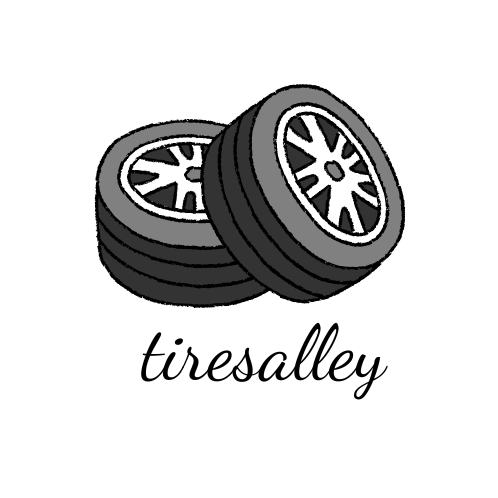Is a small chunk of tire sidewall missing? Discovering a piece of a tire sidewall missing, no matter how small, demands immediate attention and appropriate repair to ensure safety and prevent further complications.
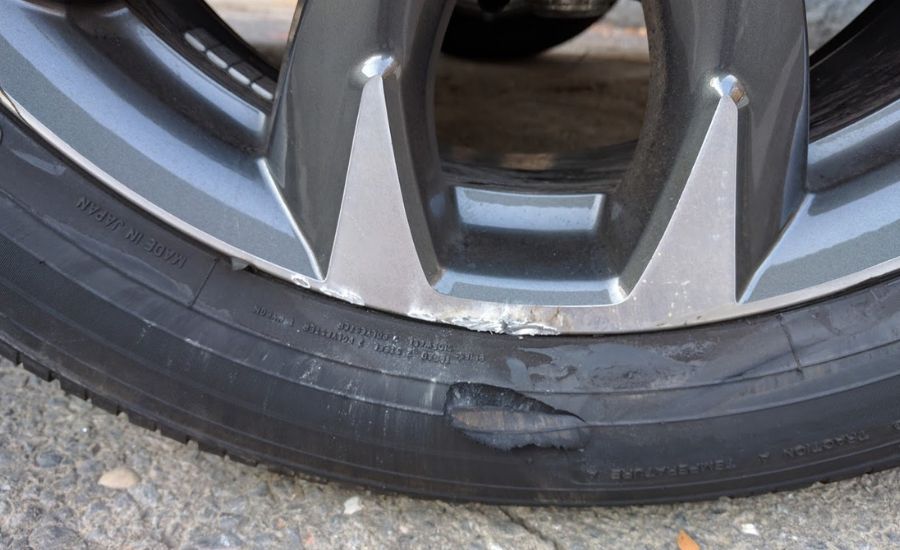
Contents
- 1 Insight 1: what is the damaged tire?
- 2 Insight 2: safety precautions
- 3 Insight 3: assessment and evaluation of a tire chunk missing
- 4 Insight 4: tire sealants
- 5 Insight 5: temporary tire patch kits
- 6 Insight 6: professional patching and vulcanizing
- 7 Insight 7: damaged sidewall reinforcement
- 8 Insight 8: signs indicating professional intervention
- 9 Insight 9: tips for sidewall maintenance
- 10 Insight 10: avoiding sidewall damage
- 11 Conclusion
- 12 FAQ
Insight 1: what is the damaged tire?
As an expert with many years of experience in this field, I can tell you that recognizing the diverse types of tire sidewall damage is vital (as sidewalls are even more sensitive than the tire’s tread area) for gauging safety risks and selecting the most suitable repair approach.
Types of tire’s sidewall damage
- Tire cuts and gashes: sharp objects or road debris can cause a cut or tire sidewall gash.
- Tire punctures: penetrations from nails, screws, or other sharp objects can lead to punctures in the tire’s sidewall.
- Tire bulges or blisters: internal damage or impacts can cause bulges or blisters on the sidewall, indicating structural weakness.
- Tire cracking: age, prolonged exposure to the elements, or inadequate maintenance can result in cracks on the entire sidewall.
Factors affecting sidewall integrity
Road conditions: poorly maintained roads, potholes, debris, and rough surfaces increase the risk of sidewall damage.
Driving habits: aggressive driving, hitting curbs, or driving over obstacles can impact sidewall integrity.
Tire age: aging tires may become more susceptible to sidewall damage due to material degradation.
Tire quality: lower-quality tires or those with manufacturing defects might have weaker sidewalls prone to damage.
Underinflation/overinflation: incorrect pressure reduces the tire’s ability to grip and can exert uneven stress on the sidewall, potentially leading to damage.
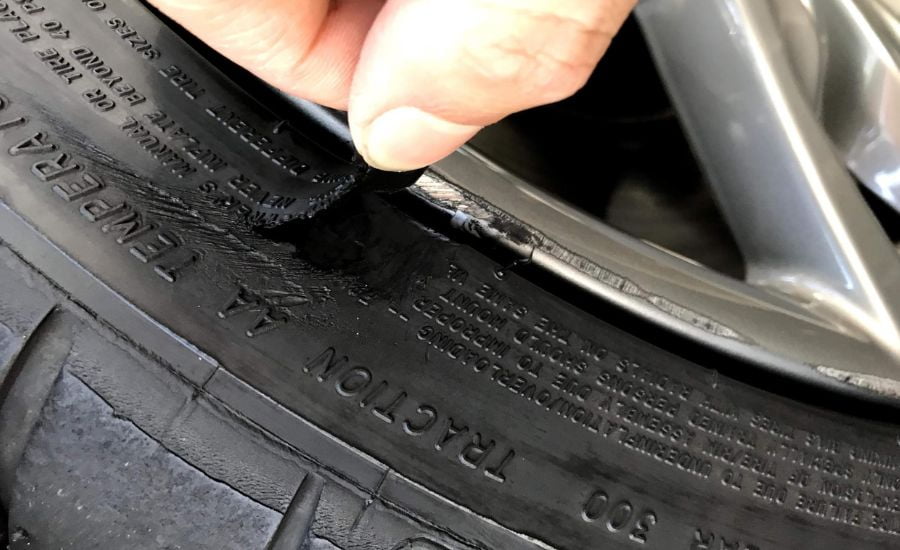
Insight 2: safety precautions
I always advise my clients that prioritizing safety precautions when dealing with damaged tire sidewalls is fundamental to mitigating risks and ensuring safe driving conditions.
Importance of safety measures
- Risk mitigation: implementing safety precautions reduces the likelihood of accidents caused by compromised tire integrity.
- Personal safety: ensuring proper tire condition through safety measures safeguards most drivers and passengers from potential accidents.
Risks associated with driving on damaged tire sidewalls
- Tire blowout: damaged sidewalls increase the risk of sudden tire blowouts, leading to further damage and a major accident.
- Loss of handling and control: even a minor chunk of tire sidewall damage can compromise tire stability, affecting vehicle handling and control.
- Exacerbated damage: driving on damaged sidewalls can exacerbate the problem, leading to further damage and more extensive and costly repairs or even tire replacement.
- Increased accident risk: driving with a small chunk of tire sidewall missing heightens the likelihood of accidents, especially during high-speed travel or adverse road conditions.
Insight 3: assessment and evaluation of a tire chunk missing
Thorough assessment and evaluation techniques for a tire chunk missing are key in determining the extent of sidewall damage.
Inspection techniques for a chunk of tire sidewall damage
- Visual examination: most drivers can conduct a thorough visual inspection of the sidewalls, looking for tire cuts, bulges, punctures, or any tire irregularities.
- Tactile assessment: run your hand along the sidewalls to detect any abnormalities, bulges, or uneven tire surfaces that may indicate damage.
- Use of soapy water: applying soapy water to the sidewall and observing for air bubbles can identify a small chunk missing, tire punctures, or leaks not easily visible.
- Pressure check: monitoring tire pressure regularly helps detect
- changes that might indicate sidewall damage or tire leaks.
Determining repair feasibility of a tire chunk missing
- Size and location of damage: evaluate the size, depth, and location of the sidewall damage to determine if it’s within repairable limits.
- The severity of damage: assess the severity of the damage — minor cuts or punctures may be repairable, while extensive damage might necessitate tire replacement.
- Tire age and condition: consider the tire’s overall condition and age; older or excessively worn tires might not be suitable candidates for repair and must be replaced sooner rather than later.
- Professional opinion: consult a qualified tire professional to determine the feasibility of repairing the damaged tire’s sidewall based on their expertise and assessment.
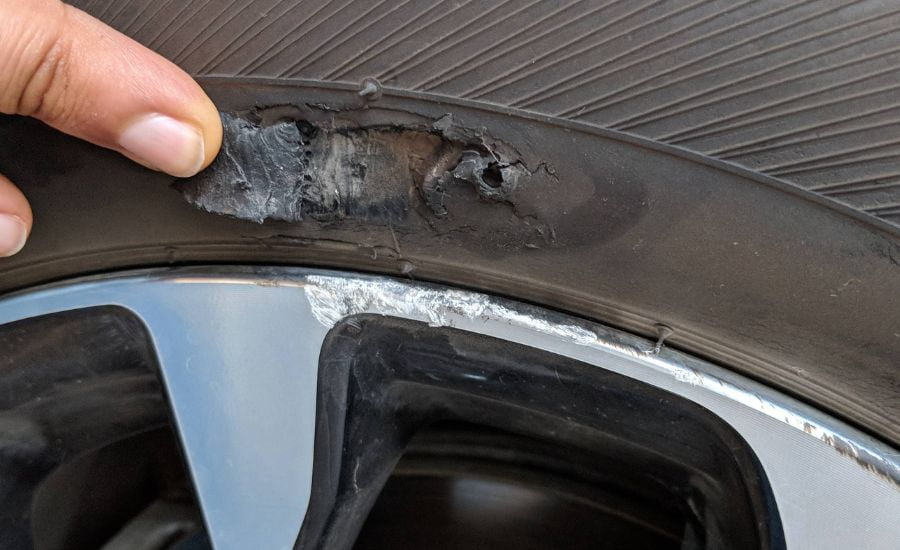
Insight 4: tire sealants
Tire sealants are a quick fix for minor punctures or leaks in the sidewall.
- Prepare & park: gather sealant kit, and gloves, and park on a safe, flat surface.
- Valve stem & cap: find the valve stem, remove the cap, and deflate the tire completely.
- Attach sealant: connect the sealant canister tightly to the valve stem.
- Inject sealant: inject sealant into the tire as directed on the product.
Reinflate & check:
- Use an air compressor to reinflate the tire to the recommended pressure.
- Drive a quarter-mile to distribute the sealant evenly.
- Recheck pressure and monitor for leaks.
Note: tire sealants are typically used as a temporary fix and are not a permanent solution for tire damage.
Insight 5: temporary tire patch kits
Temporary tire patch kits offer a short-term solution for minor sidewall damage.
Contents: these tire patch kits usually contain adhesive patches and rubber plugs designed to cover a small hole, small chunk of tire, puncture, or small cut.
Application process:
- Clean the damaged area thoroughly with the provided tools.
- Apply adhesive to the tire patch and firmly place it over the puncture or cut.
- Some tire patch kits might involve inserting a rubber plug into the damaged area to seal it.
Limitations: tire patch kits are temporary and may not provide a solution for larger or more significant sidewall damage.
Effectiveness: they can be effective in sealing small punctures temporarily, allowing limited use until a proper repair or replacement is undertaken.
Note: temporary patch kits serve as a short-term fix for slight damage and should be followed by a professional inspection for a more permanent solution (just like tire plugs for the tire thread).
They are best suited for emergencies to enable limited travel until a comprehensive repair can be arranged.
Also, remember that using tire plugs for a tire sidewall is not recommended.
Insight 6: professional patching and vulcanizing
Patching and vulcanizing present a more comprehensive way to repair sidewall damage temporarily.
Procedure:
- Clean the damaged area thoroughly.
- Apply a specialized rubber patch using vulcanizing adhesive to bond and seal the damaged area.
- Vulcanization involves using heat and pressure to fuse the patch with the tire, enhancing its durability.
Proficiency required: this method often requires specialized skills and equipment, typically performed by trained professionals.
Effectiveness: offers a more durable solution than sealants or temporary patch kits for larger or moderately sized sidewall damage.
Note: patching and vulcanizing provide a temporary but more robust solution for sidewall damage, allowing for extended use until a permanent repair or tire replacement can be arranged.
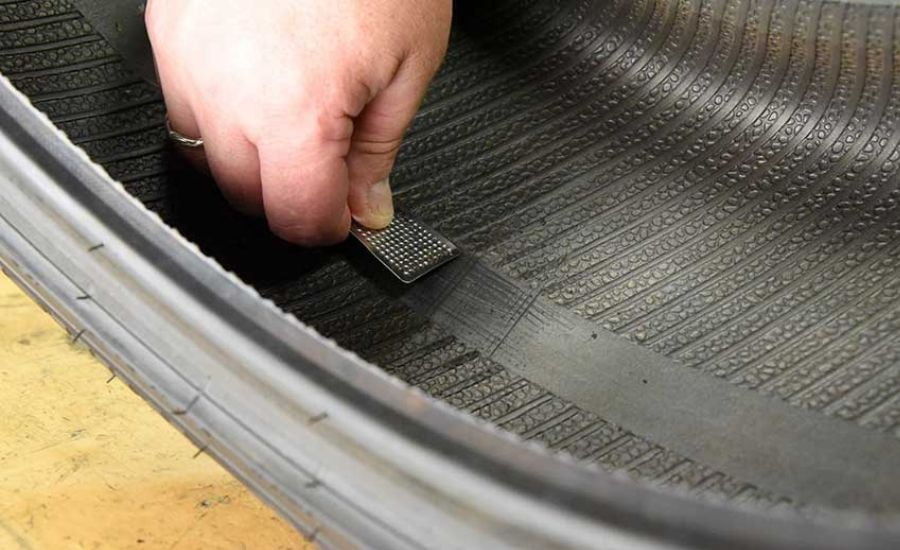
Insight 7: damaged sidewall reinforcement
Purpose: reinforcement involves applying external reinforcements or sidewall protectors to strengthen and secure damaged tire areas.
Materials used: kevlar inserts, rubber protectors, or tire sidewall overlays are commonly used.
Application process:
- Clean and prepare the damaged area for application.
- Apply the reinforcement material over this tire section using adhesive or bonding techniques.
Effectiveness: offers increased sidewall strength and protection against further damage.
Limitations: while providing enhanced protection, it might not be suitable for all types or extents of damage. A professional assessment is advised.
Note: sidewall reinforcement offers added protection and strength to damaged areas, but it’s typically a temporary measure to enable limited use until a more permanent solution can be arranged or the tire replaced.
Professional advice is crucial to ensure suitability and effectiveness.
Insight 8: signs indicating professional intervention
- Visible structural damage: any visible or extensive structural damage to the sidewall, such as large cuts, tears, or bulges, warrants immediate professional inspection.
- Persistent air loss: if the damaged sidewall continues to lose air even after using temporary fixes like sealants or patch kits, it indicates a need for a professional assessment.
- Unusual vibrations or handling issues: unexplained vibrations, wobbling, or changes in vehicle handling, especially after sidewall damage occurrence, signify a need for professional inspection.
- Tire age and wear: older tires or those with substantial wear should be evaluated by a professional even for minor damage due to potential increased vulnerability.
- Unsurety about DIY fixes: if unsure about the effectiveness or suitability of DIY repairs or temporary fixes, seeking professional help ensures proper assessment and necessary action.
Insight 9: tips for sidewall maintenance
Regular inspections: conduct frequent visual inspections of the sidewalls for any signs of damage, cuts, bulges, or unusual wear patterns.
Proper tire inflation: maintain recommended tire pressure to prevent excessive stress on sidewalls and avoid potholes, reducing the risk of damage and ensuring optimal performance.
Monitor tread depth: keep track of tire tread depth and replace tires as they near the recommended tread-wear indicators to prevent sidewall stress due to worn-out tires.
Temperature and storage conditions: store tires in a cool, dry place away from direct sunlight to prevent sidewall damage caused by extreme temperatures or UV exposure.
Wheel alignment and balancing: ensure proper wheel alignment and balancing to prevent uneven wear on tires, minimizing stress on the sidewalls.
Professional inspection: periodically have your tires inspected by a qualified technician for comprehensive checks, especially after encountering rough road conditions or prolonged use.
Insight 10: avoiding sidewall damage
- Mind road conditions: be vigilant while driving and avoid rough terrains, potholes, or debris-laden roads that can cause potential sidewall damage.
- Steer clear of curbs: exercise caution when parking or driving near curbs, as scraping against them can result in sidewall abrasions or cuts.
- Avoid overloading: adhere to the vehicle’s weight limits and avoid overloading to prevent excess stress on the tires’ sidewalls.
- Smooth driving habits: avoid sudden impacts or aggressive maneuvers that could strain the sidewalls, leading to potential damage.
- Mindful cleaning: while cleaning your vehicle, be cautious around tires to avoid using harsh chemicals or abrasive materials that might harm the sidewalls.
- Timely replacement: replace tires within their recommended lifespan or when visible signs of wear or damage on sidewalls are observed.
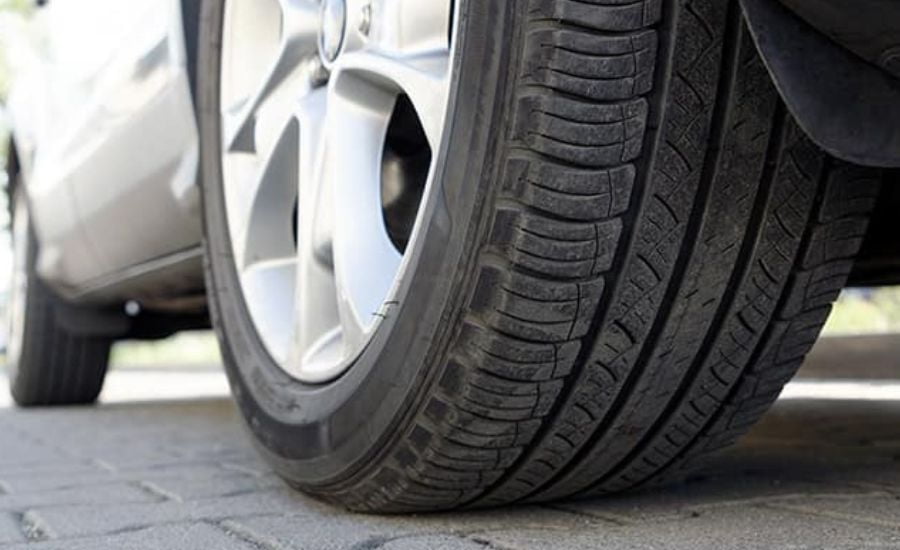
Conclusion
Maintaining vigilance, prompt attention to damage, and adherence to preventive measures are crucial for preserving tire sidewall integrity and ensuring safe road travel. I hope my guide was useful for you.
Be free to ask any questions, I am glad to answer everyone!
FAQ
Why is my tire missing chunks?
A small chunk of tire sidewall missing might be due to road hazards, impacts with sharp-edged objects, or tire wear.
Is it bad to have a chunk out of your tire?
Yes, a small chunk of tire sidewall missing might compromise tire integrity, affecting safety and performance.
Is minor sidewall damage OK?
Minor damage may be manageable temporarily but should be inspected for potential risks and addressed promptly.
Can I use a tire plug on a tire sidewall?
Using a tire plug on a sidewall is not recommended. A tire plug is typically designed for repairing punctures on the tire tread. Using a tire plug on the sidewall may not provide a secure or reliable repair. A tire plug does not effectively seal sidewall damage, potentially leading to safety hazards.
